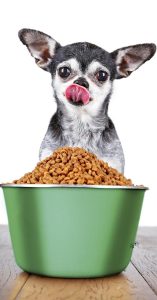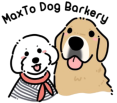
Alright, folks, let’s dive in and bust some of those dog food myths that have been floating around like stubborn balloons at a birthday party. You know the ones I’m talking about—they seem harmless but could use a little deflating.
First, there’s the grain-free craze—a trend that’s taken over faster than you can say “quinoa.” Next is the idea that our canine pals should only eat meat. It’s easy to see where this comes from; we imagine their ancestors sprinting through forests hunting prey. Then there’s the age-old mantra: “table scraps are bad,” along with the myths of picky eaters and “premium is best.”
Well, hold your horses—or should I say hold your kibble—because we are going to address these common dog food misconceptions one by one.
The Grain-Free Debate: What’s the Real Deal?
Let’s start with the grain-free debate and see what’s really going on here. You’ve probably stood in the pet food aisle, squinting at labels and wondering if your pup should be munching on grains or not. So, let’s break down some healthy dog food facts together.
First up, the grain-free dog food myth. There’s been a lot of chatter about how grains might not be great for our furry friends. But here’s the thing: grains aren’t necessarily bad for dogs! In fact, they’re a good source of carbs and can provide essential nutrients like fiber and vitamins. Some pups do just fine with grains in their diet.
Grain-free dog food is not necessary unless your dog has a specific allergy, as grains can be a healthy, nutrient-rich part of their diet.
Now, I know what you’re thinking—what about those grain-free options that seem to be popping up everywhere? Well, it turns out that unless your dog has a specific allergy or sensitivity to grains (which is pretty rare), they don’t necessarily need to go grain-free. It’s kind of like when we humans jump on every new diet trend without really needing to—sound familiar?
So how do you decide between grain-inclusive vs. grain-free? It all boils down to knowing your dog’s unique needs. If your pup’s thriving on their current kibble with grains, there’s no need to switch things up just because it’s trendy.
At the end of the day, every dog is different—just like us! The best thing you can do is keep an eye on how they’re doing health-wise and chat with your vet if you’ve got concerns. After all, we all want our four-legged pals to live their best lives!
Raw Diets: Is It Worth All the Bark?
Next, let’s dive into the world of raw diets for our furry pals. It’s a bit like the wild west out there, isn’t it? You’ve probably heard whispers at the dog park or scrolled past heated debates online about whether raw diets are the holy grail of healthy food for dogs or just another raw dog food myth. So, is it worth all the bark?
Picture this: your pup’s ancestors roaming free, catching their dinner on the run—no kibble in sight. That’s what proponents of raw feeding often hark back to when they talk about its benefits. It’s all about going back to basics with fresh meats and veggies that mimic what dogs might have eaten before we domesticated them and started serving up bowls of processed chow.
A raw diet for dogs may have benefits, but it’s important to balance it with cooked meals and consider your dog’s unique needs.
Now, I’m not saying you should toss out your oven mitts just yet! The debate between raw vs. cooked diet for dogs is as lively as a game of fetch with a squirrel in sight. Raw enthusiasts rave about shinier coats and cleaner teeth—it’s like giving your dog a spa day from within! But hey, let’s not forget that cooking can help eliminate some pesky bacteria lurking around.
For me, it’s about balance and finding what works best for each unique furball. My Max thrives on a mix—a little kitchen magic with cooked meals sprinkled with some raw treats here and there to keep things exciting (and his tail wagging). It’s kinda like having both pizza night and salad days in one week!
In the end, whether you’re team raw or team cooked (or somewhere delightfully in between), remember: every pup’s different. What matters most is seeing those happy eyes and healthy bounce in their step every day!
Avoiding Table Scraps: Are Human Foods Really That Bad?
This is a topic that’s probably crossed every dog lover’s mind at some point—those irresistible puppy eyes staring up at you from under the table. Yep, we’re talking about table scraps. You know, when your furry friend acts like they’ve never been fed in their life just because you’re eating something that smells oh-so-good. But here’s the big question: Are human foods really that bad for our dogs?
First off, let me say I totally get it. Max and Mantou have perfected their “starving artist” routine whenever there’s food around. But as much as we want to share everything with our fur babies (because who can resist those eyes?), it’s important to know what’s safe and what isn’t.
Some human foods, like cooked chicken and vegetables, are safe for dogs, but others, like chocolate and onions, can be harmful.
There’s a common myth floating around that all human foods are a no-go for dogs. But the truth is, some human foods can actually be part of a natural dog diet! For example, plain cooked chicken or turkey can be a great protein source for your pup. And veggies like carrots and green beans? Totally safe and even healthy!
However, not all table scraps are created equal, my friends. Foods like chocolate (no surprise there), grapes, onions, and anything with caffeine should be kept far away from those curious noses.
So next time Max gives me his best “please feed me” look while I’m munching on my stir fry Hokkien noodles, I remind myself of these guidelines—and maybe sneak him a carrot stick instead! Remembering what’s safe ensures our pups stay happy and healthy without missing out on the fun of sharing meals together.
Got any favorite safe treats you share with your pooch? Let me know—I’m always looking for new ideas to spoil Max and Mantou just right!
Spoiled by Choice: The Myth of Picky Eaters

It’s time to talk about the myth of the picky eater dog. If you’ve ever found yourself staring at a bowl of untouched kibble and then at your pooch with a look that says, “Really? Again?”—you’re not alone.
Let me paint you a picture. You’re standing in the pet food aisle at your local supermarket, staring at a plethora of choices: Black Hawk, Supercoat, Ziwi Peak, Optimum, and other home brands like Woolworths and Coles dog food. Each bag promises nirvana for your furry friend’s taste buds. But then you get home, pour out the new delicacy with great anticipation, only to be met with a sniff and an unimpressed glance from your beloved pup.
Now here’s the kicker: are our dogs really picky eaters, or have we just spoiled them rotten with choices? It turns out, it might be more of the latter! Dogs are naturally inclined to appreciate variety—just like us humans who can’t have pizza every day (as much as we’d love to).
But fear not! Encouraging healthy eating habits in dogs doesn’t mean resigning yourself to being a short-order cook for Fido. Start by introducing natural treats for dogs into their diet as rewards for trying new foods—or simply because they’ve mastered that adorable head tilt trick again.
And remember: patience is key when catering to these choosy pups. Sometimes it takes a little trial and error before finding what makes their tail wag most vigorously. So next time you’re contemplating which gourmet meal will finally win over your furry friend’s heart (and stomach), take comfort in knowing that this journey is all part of being an awesome pet parent—and hey, isn’t it worth it when they finally lick their bowl clean?
Dogs may appear picky due to being spoiled with too many food options, but with patience and healthy encouragement, they can develop better eating habits.
Busting the “Premium is Best” Myth Once and For All!
Now, I know what you’re thinking: “Premium must mean it’s the best for my pup!” But hold on a second. Just because something’s labeled as “premium” doesn’t always mean it’s top-notch for your four-legged family member. It’s like buying that fancy bottled water when good ol’ tap water would do just fine—sometimes it’s all about perception rather than reality.
Let’s chat about fresh pet food for a moment. Imagine serving up meals made with real ingredients you can actually pronounce—no mystery meats or unpronounceable additives here! Fresh doesn’t have to mean pricey; it means quality and transparency. When we talk about evaluating value versus cost in pet nutrition, it’s all about looking beyond the label and understanding what’s truly nourishing your pup.
“Premium” dog food isn’t always the best; it’s more about the quality and transparency of the ingredients rather than the label.
So next time you’re shopping for dog food, remember: it’s not just about shelling out more cash for that shiny “premium” sticker. It’s about finding what genuinely meets your furry friend’s needs without breaking the bank—or their sensitive tummies! After all, isn’t it worth taking an extra minute to ensure those puppy dog eyes are sparkling with health and happiness?
Ready to Debunk Doggie Diet Myths Together?
In conclusion, our exploration of canine nutrition underscores the importance of making informed and compassionate choices for our beloved pets. By dispelling myths and navigating the complexities of dietary options with humor and care, we ensure that every meal contributes positively to their well-being.
This journey is not just about feeding our dogs but celebrating the joy they bring into our lives through thoughtful decisions that cater to their health and happiness. As we cherish each moment with wagging tails and contented tummies, let us continue to prioritize love and understanding in every aspect of their care. Ultimately, this commitment reflects the deep bond we share with our furry companions, affirming that nothing is too good for those who bring so much joy into our lives.


